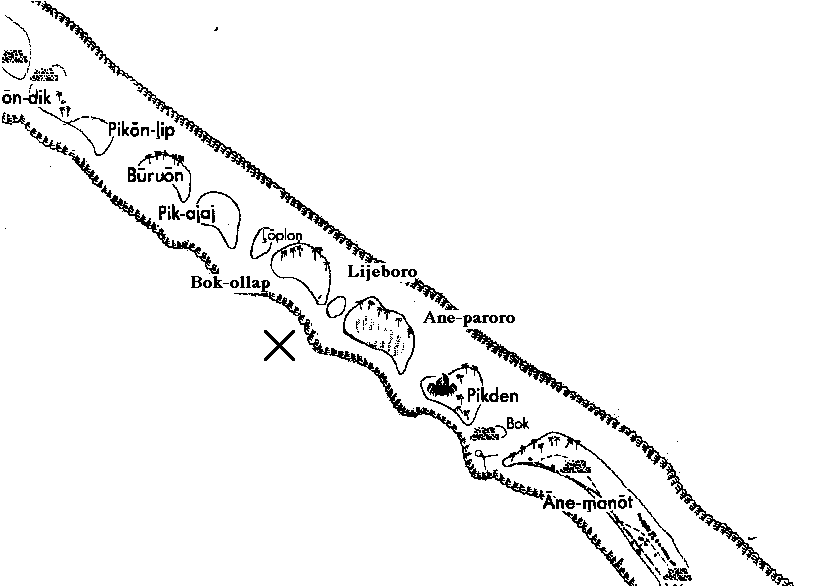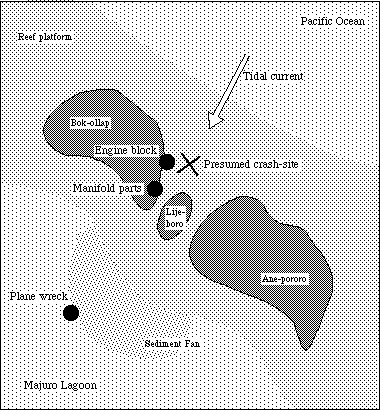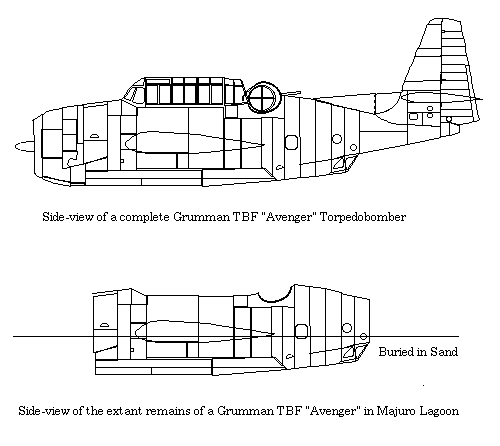

|
|
Investigation of a Grumman TBF "Avenger" aircraft submerged in Majuro Lagoon by Dirk H.R. Spennemann |
The archaeological and historical sites and artefacts of the Republic of the Marshall Islands form a finite and unrenewable resource in need of protection and proper management. In order to do so, the Historic Preservation Office conducts a series of graded, systematic surveys. At the lowest level of activity a reconnaissance survey is carried out to determine the extent of the extant information and sites. based on the results of this survey then, a more detailed survey plan is drawn up for future reference and use, once the opportunity arises to continue the work. The geographical spread of the Republic of the Marshall Islands, and here especially its non contiguous nature makes survey work within the Republic dependent on the availability of transportation between as well as within atolls.
This report presents a short assessment of the remains of an U.S. aircraft, a Grumman TBF "Avenger" torpedo bomber, which crashed sometime after the U.S. landings in the Marshall Islands on a reef north of Djarrit (Rita) Island, Majuro Atoll.

Figure 1. Map of Majuro Atoll showing the location of Bok-ollap
From the interpretation of the remains it appears that the Avenger crash landed on the reef platform, where the plane was partially or fully cannibalised by U.S. servicemen.
On the ocean shore, in the intertidal zone rests the engine block, while parts of the cylinder heads, as well as parts of manifolds can be found in the shrub of the island. At one point all three propeller blades have been removed; two of them could be pulled off, while the third one was sawn off .

Figure 2. Map of a section of the northern reef of Majuro Atoll showing the location of Bok-ollap
Parts of the fuselage, as well as parts of the tail section can be found higher up on the slope, indicating that the plane partially broke up as it slid down the sediment fan.

Figure 3. Detailed map of the islands of Bok-ollap, Lijeboro and Ane-pororo showing the location of the plane wreck.
Majuro Atoll served as a major fleet anchorage after the Battle of Kwajalein and one of the airfields was used as plane parking area to replenish carrier groups.
In addition, it appears, Majuro Atoll served as intermediate training location for air crews who came out of the mainland. These crews were set against the by-passed Japanese bases of Taroa, Mile, Wotje and Jaluit, where the crews gained limited battle experience before they were sent to the front.

Figure 4. Plan view of the extant remains of a Grumman TBF "Avenger" Torpedo bomber on the bottom of Majuro Lagoon.
The wreckage of the engine block will continue to gradually disintegrate. At present no curation or management options for the engine have been considered.
Archival research to provide further details of the plane and the fate of the crew, as well as the location of historic photographs is needed. The process has been begun by the Historic Preservation Office.
Carter, K.C & R.Mueller, 1973, The Army Air Force in World War II. Combat Chronology 1941-1945. Washington: Albert Simpson Historical Center, Air University & Office of Air Force History, Headquarters USAF.
Craven, W.F. & J.C.Kate, 1950, The Army Air Forces in World War II. Vol. 4: The Pacific: Guadalcanal to Saipan August 1942 to July 1944. Chicago: University of Chicago Press.
Crowl, P.A. & E.G.Lowe, 1955, Seizure of the Gilberts and the Marshalls. The War in the Pacific. United States Army in World War II. Washington: Office of the Chief of Military History, Department of the Army.
Cunningham, W.S., 1961, Wake Island Command. Boston: Little, Brown & Co.
Dyer, G.C., 1972, The Amphibians came to conquer. The stroy of Admiral Richmond Kelly Turner. Washington: General Printing Office.
Heinl, R.D., & J.A.Crown, 1954, The Marshalls: Increasing the Tempo. Marine Corps Monograph. Historical Branch G-3 Division, Headquarters U.S.marine Corps. Washington: U.S.Government Printing Office.
Hickey, L.J., 1986, Warpath across the Pacific. 2nd edition. Boulder, Co.: International Research and Publishing Company.
Howard, C. & J.Whitley, 1946, One damned island after another. Chapel Hill: University of North Carolina Press.
ICPOA, 1943, Enemy positions, The Marshall-Gilberts area. ICPOA Bulletin 30-43, 5 May 1943. Page 183. (Date incorrect as the report also contains information of mid-June 1943).
Morison, S.E., 1948, History of U.S. Naval Operations in World War II. Vol. III: The rising sun in the Pacific. 1931-April 1942. Boston: Little, Brown & Co.
Morison, S.E., 1951, History of United States Naval Operations in World War II. Vol VII: Aleutians, Gilberts & Marshalls.June 1942-April 1944. Boston: Little, Brown & Co.
Shaw, H.I., B.C.Nalty & E.T.Turnbladh, 1966, Central Pacific Drive: History of U.S.Marine Corps. Operations in Wolrd War II. Volume III. Washington, DC: U.S.G.P.O.
Spennemann, Dirk H.R., 1992, Archaeological and historical investigations of a Consolidated B-24 "Liberator" aircraft in Majuro Lagoon, Majuro Atoll, Republic of the Marshall Islands: a submerged cultural resource assessment. HPO-Report 1992/3. Majuro Atoll, Republic of the Marshall Islands: Historic Preservation Office.
Spoehr, A., 1949, Majuro, a village of the Marshall Islands. Fieldiana: Anthropology 39. Chicago: Chicago Natural History Museum.
USACE, 1989, US Army Corps of Engineers, Pacific Ocean Division, Majuro Atoll Coastal Resource Atlas .Honolulu HI: US Army Corps of Engineers.
USSBS 1947, United States Strategic Bombing Survey, The American campaign against Wotje, Maloelap, Mille and Jaluit. Washington: Naval Analysis Section, United States Strategic Bombing Survey.
![]()
Originally produced as:
Dirk H.R. Spennemann, 1992, Investigations of a Grumman TBF "Avenger"
aircraft in Majuro Lagoon. HPO Report N° 1992/1. Majuro
Atoll, Marshall Islands: Republic of the Marshall Islands Historic Preservation
Office.
![]()
Bibliographic citation for this document
Spennemann, Dirk H.R. (2000). Investigations of a Grumman TBF "Avenger" aircraft submerged in Majuro Lagoon..
URL: http:/marshall.csu.edu.au/Marshalls/html/WWII/Bokallep.html
![]()
CONTACT:
Dirk H.R. Spennemann,
Institute of Land, Water and Society,
Charles Sturt University, P.O.Box 789,
Albury NSW 2640, Australia.
e-mail: dspennemann@csu.edu.au
![]()
| select from the following... | ||||||
|
|
||||||
|
Digital Micronesia-An
Electronic
Library & Archive
is provided free of charge
as an advertising-free
information service
for the world community. It is being maintained by Dirk
HR Spennemann, Associate
Professor in Cultural
Heritage Management,Institute of Land, Water and Society and
School
of Environmental & Information Sciences, Charles
Sturt University,
Albury, Australia. The server
space and technical support are provided by Charles
Sturt University as part of its commitment
to regional engagement. Environmental
SciencesInformation
Sciences
|
||||||